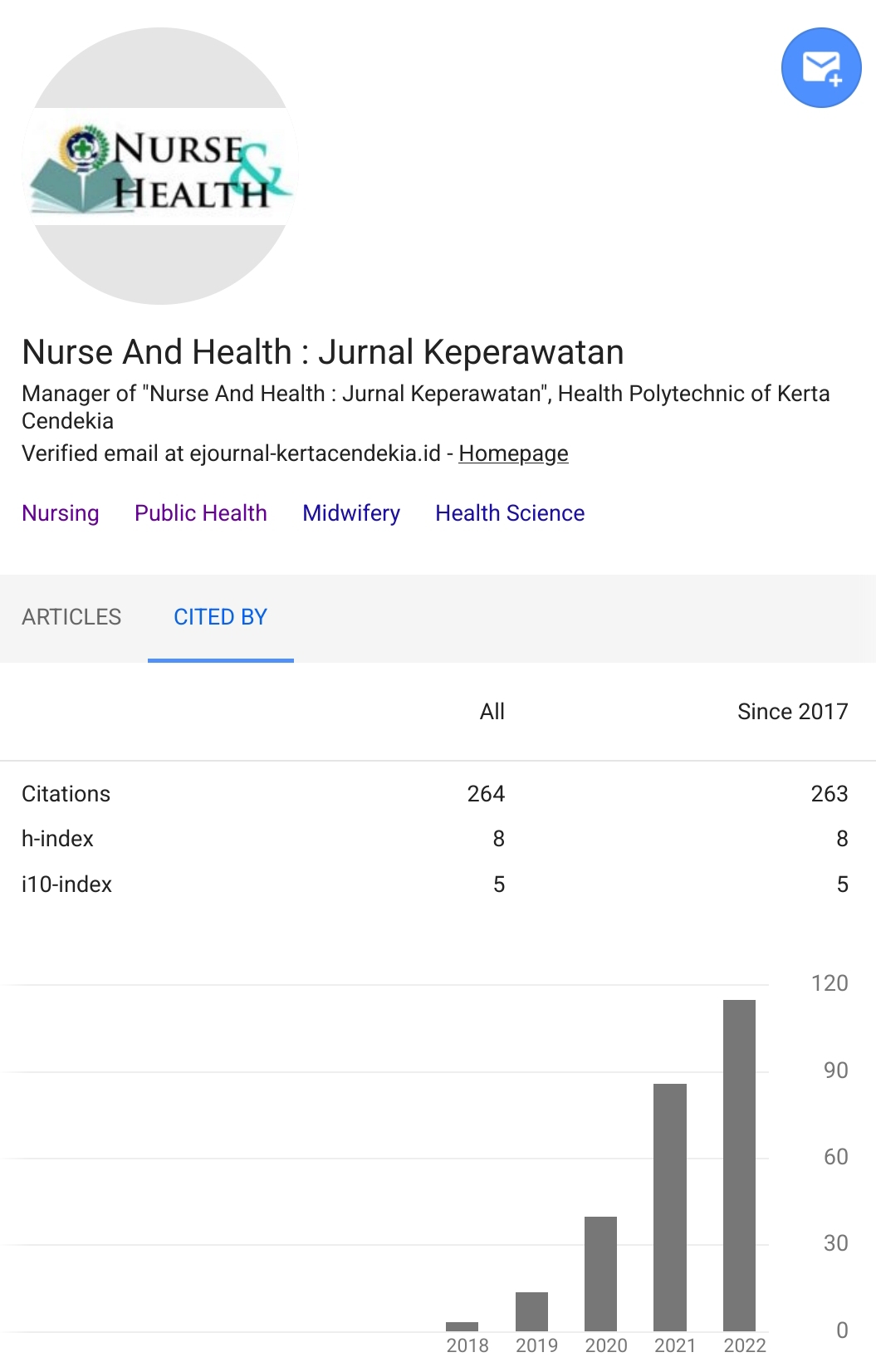DIMENSIONS OF ORGANIZATIONAL CULTURE (INVOLVEMENT, CONSISTENCY, ADJUSTMENT, AND MISSION) WITH NURSE WORK PRODUCTIVITY
Abstract
Background: Nursing is one of the service providers in hospitals that is excellent, efficient, and productive. for organizational culture at RSU Labuang Makassar obtained a moderate level of involvement of 56.7%, a high level of consistency of 53.3%. The results of these studies indicate that a strong organizational culture does not show any influence in increasing organizational effectiveness. Objectives: This study aimed to determine organizational culture with the work productivity of the nurses. Methods: This research uses quantitative research with a descriptive correlation research design. Is a questionnaire, with several variables, namely involvement, adjustment, consistency, mission, and work productivity. Data analysis using correlation analysis. The research subjects were 81 nurses. Results: There is a relationship between involvement and work productivity with p-value = .001 (r = .469). There is a relationship between consistency and work productivity with p-value = .001 (r = .782). And also, there is the relationship between adjustment and work productivity with p-value = .001 (r = .820), and the relationship between mission and work productivity with p-value = .001 (r = .635). Conclusion: The relationship between organizational culture and the work productivity of nurses has a positive impact on the hospital, where organizational culture can lead nurses to be productive.Downloads
References
Afiah, R. N., Maidin, A., Bahar, B. (2013). Budaya dan efektifitas rumah sakit (di RSUD Haji Makasar dan RSU Labuang Baji Makasar
Chegini, M. G. (2010). The relationship between organizational culture and staf productivity public organizations. Journal of Social Sciences, 6 (1), 127129. DOI: https://doi.org/10.3844/jssp.2010.127.129
Dadgar, H., Barahouei, F., Mohammadi, M., Ebrahimi, M., & Ganjali, A. (2013). The Relationship between organizational culture, job satisfaction, organizational commitment and Intention to Stay of Health Personnel's of Zahedan University of Medical Sciences, World Applied Sciences Journal ,21 (8), 1220-1228.
Denison, D. R., & Mishra, A. K. (1995). Towards a theory of organizational culture and effectiveness", organization science, 6 (2), 204-24 DOI: https://doi.org/10.1287/orsc.6.2.204
Denison, D. R., & Mishra, A. K. (1998). “Does organizational culture have an impact on quality? a study of culture and quality in ninety-two manufacturing organizations”.Presentational to the Academy of Management Convention: San Diego, CA.
Doloksaribu, M. (2001). Pengaruh budaya organisasi terhadap kinerja manajerial, Tesis.UNDIP. Tidak dipublikasikan.
Ehtesham, M., Muhammad, T. M., & Muhammad, S. A. (2011). Relationship between organizational culture and performance management practices: a case of University in Pakistan. Journal of Competitiveness, 3 (78).
Gibson, J., James, I., & John, D. (2011). Organization behavior. Boston: Mc Graw-Hill Higher Education.
Hersey & goldsmith (1980) Theory of organiztions'. 1st ed., Parsian: Shabak Publications.
Hsiao, H. C., Chang, C., & Tu, Y. T. (2012). The influence of hospital organizational culture on organizational commitment among nursing executives. African Journal of Business Management, 6 (44), 1088810895. DOI: https://doi.org/10.5897/AJBM11.1510
Hsu, H. Y. (2009). Organizational learning culture's influence on job satisfaction, organizational commitment, and turnover intention among R & D professionals in Taiwan during an economic downturn. A dissertation submitted to the Faculty of the Graduate School of the University of Minnesota.
Huber, D.L. (2014). Leaderhip & Nursing Care Management, Fifth Editio, ed:5. The University of lowa: lowa City.
Kreitner, R. & Kinicki. (2010). Organizational behavior. New York: Mc Graw Hill Higher Education.
Mougheli, A., & Azizi, A. (2011). “Human Resources Productivity Management”, Asian Journal of Business Management, 1 (7).
Minarsih, M. (2011). Hubungan beban kerja dengan produktivitas kerja perawat di IRNA non Bedah (penyakit dalam) RSUP. DR Jamil Padang. Thesis, Manajemen Keperawatan, Fakultas Keperawatan, UNAND.
Nurfitriani, M. (2011). Pengaruh budaya organisasi terhadap kinerja perawat rawat inap dirumah sakit PHC Surabaya. Tesis. UNAIR.
Polit, D.F., & Hungler, B. P. (1999). Nursing research principles and methods. Sixth Edition. New York: Lipincot.
Robbins, S. P. (1996). Perilaku organisasi, konsep, kontroversi dan aplikasi. edisi keenam. Jakarta: PT. Bhuana ilmu populer.
Robbins, S. P., & Caulter, M. (2010). Manajemen. edisi kesepuluh, jilid 1. Jakarta: Erlangga.
Rosa, E. M., Nurachmah, E., & Budiharto, B. (2012). Hubungan antara kohesivitas kelompok dan sikap perawat pelaksana dengan produktivitas kerja perawat perawat pelaksana di Ruang Rawat Inap RSUPN. Dr. Ciptomangunkusumo. Jurnal Medicoeticolegal dan Manajemen Rumah Sakit. 1 (1).
Schein, E. H. (2004). Organizational culture and leadership. third edition. John San Francisco: Wiley & Sons.
Tsai, Y. (2012). Relationship between organizational culture, leadership behavior and job satisfaction. Journal Reaserch Article BMC Health Services Research, 1186/1472-6963-11-98. DOI: https://doi.org/10.1186/1472-6963-11-98
Tseng, S. M. (2010). The correlation between organizational culture and knowledge conversion on corporate performance. Journal of Knowledge Management. 14 (2), 269-284. DOI: https://doi.org/10.1108/13673271011032409
Urrabazo, C. K. (2006). Management’s role in shaping organizational culture. Journal of Nursing Management, 14, 188-194. DOI: https://doi.org/10.1111/j.1365-2934.2006.00590.x
Copyright (c) 2021 Anas Budi, Armawati Abidin

This work is licensed under a Creative Commons Attribution-NonCommercial 4.0 International License.
Authors who publish with Nurse and Health: Jurnal Keperawatan agree to the following terms:
- Authors retain copyright licensed under a Creative Commons Attribution-NonCommercial 4.0 (CC BY-NC 4.0), which allows others to remix, tweak, and build upon the authors' work non-commercially, and although the others' new works must also acknowledge the authors and be non-commercial, they don't have to license their derivative works on the same terms.
- Authors are permitted and encouraged to post their work online (e.g., in institutional repositories or on their website) prior to and during the submission process, as it can lead to productive exchanges, as well as earlier and greater citation of published work (See The Effect of Open Access). Authors can archive pre-print and post-print or publisher's version/PDF.








_resize1.jpg)















